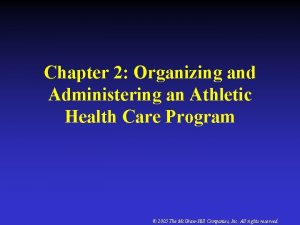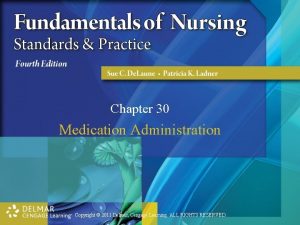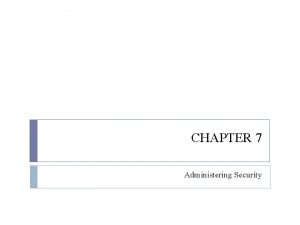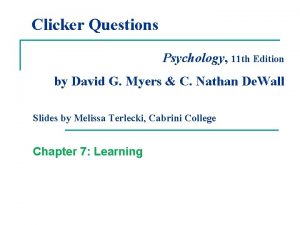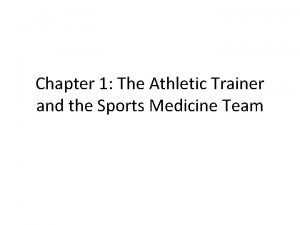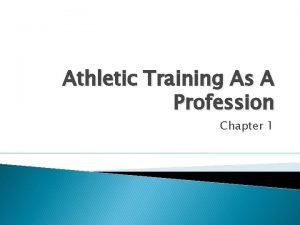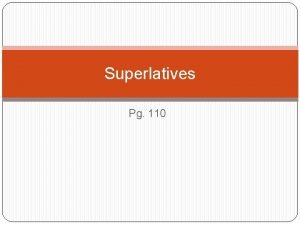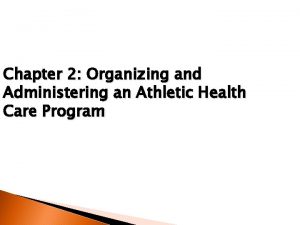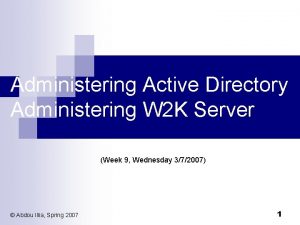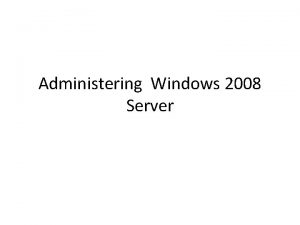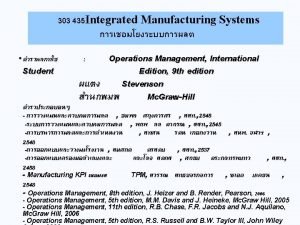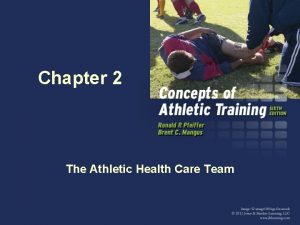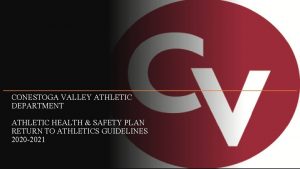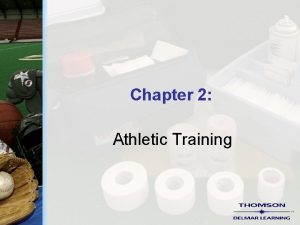CHAPTER 2 ORGANIZING AND ADMINISTERING AN ATHLETIC HEALTH

















- Slides: 17

CHAPTER 2: ORGANIZING AND ADMINISTERING AN ATHLETIC HEALTH CARE PROGRAM

All must have policies and procedures for clear expectation HEALTH CARE PROGRAMS

1. No cleated shoes are allowed, 2. Game equipment is kept outside. 3. Shoes must be kept off treatment tables. 4. Athletes should shower before receiving treatment. 5. Roughhousing and profanity are not allowed. 6. No food or smokeless tobacco is allowed. RULES IN ATHLETIC TRAINING FACILITY

Sweep Clean Mop floors daily. and disinfect sinks and built-in tubs daily. and disinfect hydrotherapy area twice a week. Refill paper towel and drinking cup dispensers as needed. Empty wastebaskets and dispose of trash daily. Clean and disinfect treatment tables daily. Clean and disinfect hydrotherapy modalities daily. Clean and polish otherapeutic modalities weekly. SANITATION IN ATHLETIC TRAINING ROOM

Sweep Clean the gymnasium floors daily. and disinfect drinking fountains, showers, sinks, urinals, and toilets daily. Air out and sanitize lockers frequently. Clean Urge wrestling mats and wall mats daily. the use of clean dry towels each day for each individual athlete. Issue individual equipment and clothing to each athlete to avoid skin irritations. Do not allow swapping of equipment and clothing. Launder Allow and change clothing frequently. wet clothing to dry thoroughly before the athlete wears it again. SANITATION OF ATHLETIC FACILITIES

Are the athletes medically cleared to participate? Is each athlete insured? Do the athletes promptly report injuries, illnesses, and skin disorders to the coach or the athletic trainer? Do the athletes practice good daily living habits of resting, sleeping, and proper nutrition? Do they shower after practice? Do they dry thoroughly and cool off before departing from the gymnasium? Do they avoid drinking from a common water dispenser? Do they avoid using a common towel? Do they avoid exchanging gym clothes with teammates? Do they practice good foot hygiene? Do they avoid contact with teammates who have a contagious disease or infection? RECOMMENDED HEALTH PRACTICES CHECKLIST

Posted at all athletic venues. Outlines who does what in times of emergencies (injuries, weather emergencies, etc. ) Sample – handout Sample - University emergency action plan EMERGENCY ACTION PLAN (EAP)

Medical Injury records reports Treatment Personal Injury logs information cards evaluation and progress notes Supply and equipment inventories Annual reports RECORD KEEPING

Medical history - identify past or existing medical problems Physical exam – assessment of height, weight, body composition, blood pressure, pulse, vision, skin, teeth, ears, nose, throat, heart and lung function, abdomen, lymphatics, genitalea, maturation index, urinalysis, blood work. Maturity assessment – sexual maturity, skeletal, dental assessment (Tanner’s five stages of assessment – common) Orthopedic screening (pg. 32) - may make recommendation for disqualification NC high school sample - Physical Examination University sample - Physical Examination PREPARTICIPATION EXAMS (PPE)

HIPAA – regulates access to records FERPA – protects student education records Keep past records on file about 7 years MEDICAL RECORDS

Keep Get on file quotes – compare direct buy to competitive bid Equipment – fixed (stays in athletic training room – such as ice machine, therapeutic modalities, etc. ) or not fixed (may be used outside the athletic training room – such as medical kits, scissors, etc. ) BUDGET

Ideally 1, 000 -1, 200 square feet Adjacent Contain to locker rooms storage Different areas – taping/bandaging, injury treatment using rehabilitation equipment, wet area, private evaluation area, office ATHLETIC TRAINING ROOM

Washington

Tuscarora High School, Virginia

Utah Football Center

Guilford College

1. Hiring a certified athletic trainer in a faculty-trainer capacity. This is done in some other counties. Here in Forsyth County, the head athletic trainer cannot be a teacher. 2. Using a certified graduate student from a nearby college or university. There are certain guidelines to follow to get graduate students. A certified athletic trainer has to be on site and as a supervisor for the students. 3. School district employs a centrally place certified athletic trainer. This would not work with sports like football and wrestling where someone has to be present. 4. School contracts with a clinic to provide a certified athletic trainer. This is similar to what Forsyth County does. Baptist and Forsyth Memorial Hospitals originally started the contract system to get a certified athletic trainer in every high school. HIRING AN ATHLETIC TRAINER
 Chapter 2 worksheet organizing and administering
Chapter 2 worksheet organizing and administering Chapter 23:1 performing range of motion exercises
Chapter 23:1 performing range of motion exercises Chapter 30 administering medications
Chapter 30 administering medications Chapter 30 administering medications
Chapter 30 administering medications External environments and accountability of schools ppt
External environments and accountability of schools ppt Im injection sites and volumes pediatrics
Im injection sites and volumes pediatrics Administering security
Administering security Mental representation of one's layout is called
Mental representation of one's layout is called Administering active directory
Administering active directory Chapter 1 athletic training as a profession
Chapter 1 athletic training as a profession Chapter 1 athletic training as a profession
Chapter 1 athletic training as a profession Chapter 3 health wellness and health disparities
Chapter 3 health wellness and health disparities Chapter 1 lesson 2 what affects your health
Chapter 1 lesson 2 what affects your health Chapter 1 health and wellness fundamentals
Chapter 1 health and wellness fundamentals Chapter 17 organizing life's diversity answer key
Chapter 17 organizing life's diversity answer key Athletic comparative and superlative
Athletic comparative and superlative Health and social component 3
Health and social component 3 Staffing directing and controlling
Staffing directing and controlling
